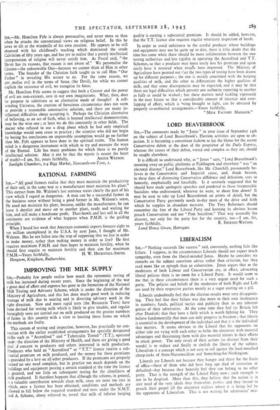IMPROVING THE MILK SUPPLY
Stn,—Probably few people realise how much the systematic testing of milk has increased during recent years. Since the beginning of the war a great deal of effort and expense has gone to the formation of the National Milk Testing and Advisory Scheme, which is under the direction of the Ministry of Agriculture, and this has done much good work in reducing wastage of milk due to souring and in directing advisory work in the right direction. New and more rapid tests (the Resazurin Tests) have been devised for testing milk which is likely to give trouble, and regular fortnightly tests are carried out on milk produced on the greater numbers of farms in this country with a view to locating those farms on which the methods are faulty.
This system of testing and inspection, however, has practically no con- nection with the earlier established arrangements for specially designated milks such as "Accredited " and " Tuberculin Tested " (T.T.), operated under the direction of the Ministry of Health, and these are giving a good deal 4Jf concern to producers and others interested in milk production. ProdUcers who hold an " Accredited " or " T.T." licence receive a sub- stantial premium on milk produced, and the money for these premiums is provided by a levy on all other producers. If the premiums are properly earned no one need complain, but in practice too much depends on the buildings and equipment passing a certain standard at the time the licence is granted, and too little on subsequent testing for the cleanliness of milk produced. It therefore happens that although the scheme, in general, is a valuable contribution towards clean milk, cases are none too rare in which, once a licence has been obtained, conditions and methods are allowed to fall below the required standard and tests under the N.M.T. and A. Scheme, above referred to, reveal that milk of inferior keeping
quality is earning a substantial premium. It should be added, however, that the T.T. licence also requires regular veterinary inspection of herds.
In order to avoid unfairness to the careful producer whose buildings and equipment may not be quite up to date, there is little doubt that the time has come when there should be more collaboration between the two testing authorities and less rigidity in operating the Accredited and T.T. Schemes, so that a producer may more easily lose his premium and again easily have it restored when results have improved. The Ministry of Agriculture have pointed out Oat the two types of testing have been drawn up for different purposes ; the one is mainly concerned with the keeping qualities of milk, and the other to differentiate the higher qualities of milk, and that some discrepancies may be expected, and it may be that there are legal difficulties which prevent one authority reporting to another as fully as could be wished ; but these matters need tackling vigorously in the near future so that a considerable amount of injustice and over- lapping of effort, which is being brought to light, can be obviated by properly co-ordinated arrangements.—Yours faithfully, " MILK FACTORY MANAGER."


























 Previous page
Previous page